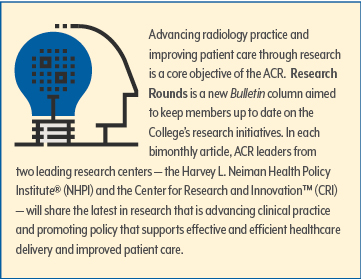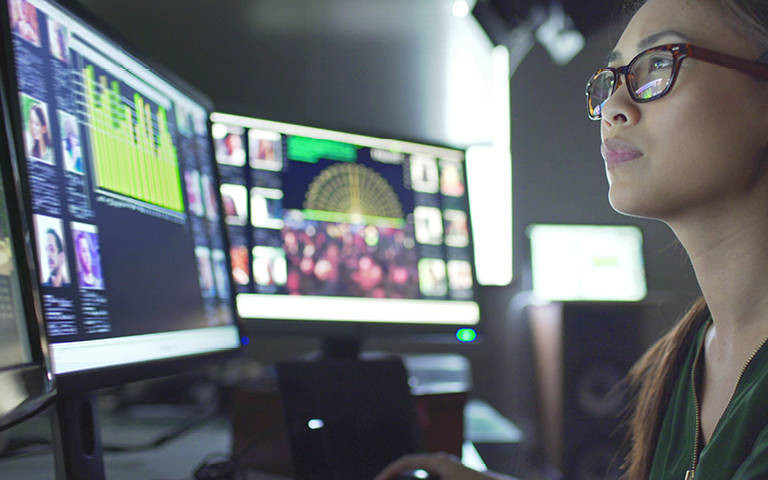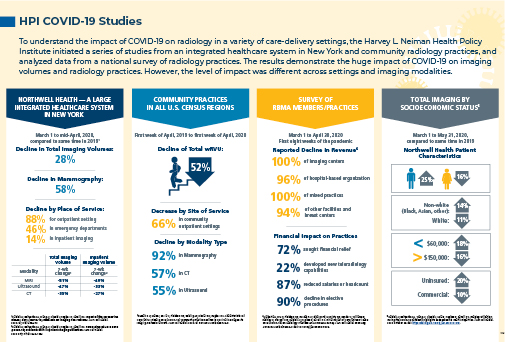With the sudden onset of the pandemic in March, radiologists were eager to know whether the impact observed at their practices was also being seen throughout the country. Furthermore, policymakers and their constituents needed to understand the indirect consequences of the pandemic. With Americans advised (or ordered) to stay at home, and fearful of COVID-19, it was important to understand changes in imaging that could translate to gaps in care, missed diagnoses, and delayed treatments — and, conversely, whether increased case rates of COVID-19 were driving up imaging in some categories. The five studies completed to date tell a story of dramatic declines in imaging that started immediately after the first COVID-19 cases were diagnosed in New York.

Northwell Health, New York’s largest healthcare provider and a Harvey L. Neiman Health Policy Institute® (NHPI) research partner, presented a perfect case study of the first U.S. COVID19 hot spot. Therefore, Northwell data offered a leading indicator of what might occur in other parts of the country.
Two additional approaches evaluated how imaging was impacted in other parts of the country. First, data was collected from community practices across all regions of the U.S. Next, a survey of 228 radiology practices explored broader concerns from the practice perspective.
At Northwell, during the first seven weeks after COVID19 hit last spring, there was a 28% decrease across all imaging, compared to 2019. Strikingly, outpatient imaging dropped by 88% and ER imaging by 46% — in contrast to the 14% inpatient decline. By modality, mammography took the biggest hit, with a 58% decline. In mid-April, mammography hit its lowest point, coming in 94% lower than the previous year.1
A second study explored Northwell’s inpatient imaging in more detail and found that the changes in most imaging modalities — CT, MRI, and mammography — were comparable to the global changes. The key exception was radiography, which exhibited a small 4% increase in the inpatient setting and a smaller decline in US. In the inpatient setting, US declined by 33% (compared to the 47% drop across all settings).2 Lung X-ray and US have been key to identifying and treating respiratory problems stemming from COVID-19, such as pneumonia, and may have accounted for the lesser drop in the inpatient setting.
A separate study of potential health disparities found that the pandemic also created distinct changes in the demographics and socioeconomics of patients receiving imaging. Imaging services at Northwell increased in groups that have historically received less imaging but are known to be more susceptible to the coronavirus infection: men, minorities, lower income, and the uninsured.3
The analysis of national community practices was no less bleak. There was an overall 52% decrease in imaging in the first week of April, which was slightly higher in the outpatient setting (66%). Mammography was down by 92%, which was almost equivalent to the 94% drop observed at the nadir at Northwell. CT and radiography both decreased by about 30% in community practices.4
Not surprisingly, radiology practices endured major challenges as a result of the pandemic. Revenue for all types of practices in April was cut by more than half, on average, according to survey data. More than 70% of practices applied for financial relief, but 87% still had to cut positions or reduce salaries. In response to the pandemic, almost a quarter of surveyed practices developed teleradiology capabilities.5
From a policy perspective, it is important for national, state, and local leaders to understand the unintended consequences of the pandemic on other aspects of health. The observed decline in mammography is a key example of how COVID-19-related restrictions — or personal choices to reduce risk — could translate to adverse health consequences for an unrelated disease. For example, cancelled or deferred mammograms could result in a swift rise in breast cancer cases identified too late to avoid progression.
Promoting safe protocols for patients to get the imaging they need to stay healthy is clearly critical as COVID-19 cases are still rampant across the country. However, the extra resources, staff, and PPE required to ensure safety pose additional costs to practices. CMS should consider reimbursement that accounts for these extra expenses.
Finally, as we look toward recovering from the pandemic, public health campaigns need to encourage patients to reschedule any missed appointments, screenings, or treatments. These campaigns, combined with communications from healthcare and insurance providers, will be critical to minimize the indirect and broader consequences of this crisis for public health.


